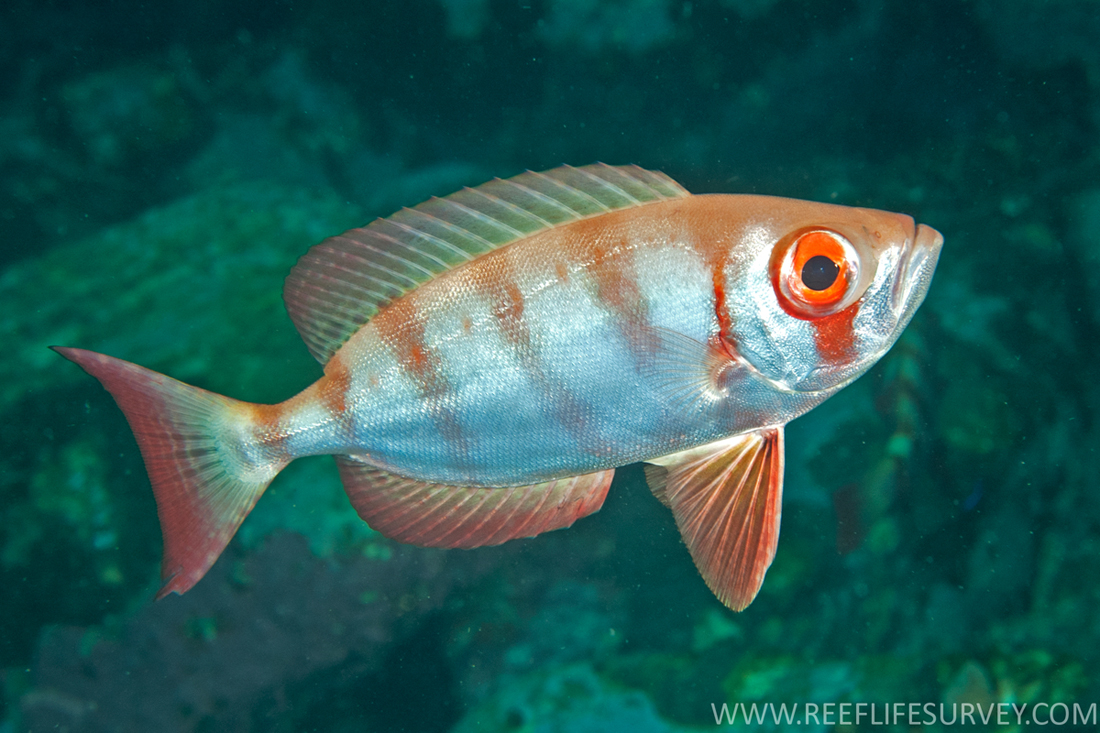Lunartail Bigeye, Priacanthus hamrur (Forsskal 1775)
Other Names: Black-spot Big-eye, Crescent-tail Bigeye, Crescent-tail Big-eye, Crescent-tailed Bigeye, Lunar-tailed Bigeye, Lunar-tailed Glasseye, Moontail Bullseye

A Lunartail Bigeye, Priacanthus hamrur, at South Solitary Island, New South Wales. Source: Ian V. Shaw / Reef Life Survey. License: CC by Attribution
Summary:
An entirely red bigeye sometimes with indistinct darker spots along the lateral line, and a distinctly crescent-shaped or convex tail. The species is able to rapidly change to silvery pink with about six reddish bars or large spots along the side.
Cite this page as:
Bray, D.J. 2022, Priacanthus hamrur in Fishes of Australia, accessed 24 Apr 2024, https://fishesofaustralia.net.au/home/species/4462
Lunartail Bigeye, Priacanthus hamrur (Forsskal 1775)
More Info
|
Distribution |
Houtman Abrohlos, Western Australia, around the tropical north to Shellharbour, New South Wales, including Coral Sea Islands, Queensland; also the Lord Howe Province in the Tasman Sea. Elsewhere the species occurs in the tropical, Indo-west-central Pacific: Red Sea & South Africa, east to the Marquesas and Gambier Islands, north to southern Japan, New Caledonia and Tonga. Inhabits outer reef slopes, deep lagoon pinnacles and more sheltered areas, sometimes sheltering beneath ledges or near coral heads during the day. Individuals form small aggregations or sometimes large schools around in oceanic areas. |
|
Features |
Dorsal fin X,13-15; Anal fin III, 13-15; Pectoral fin 17-19; Lateral-line scales 69-77; Gill rakers 3-5 + 14-17. Body depth 2.5-2.9 in SL, body strongly compressed laterally; mouth oblique, upturned, end of lower lip above midline of body; preopercular spine very short, inconspicuous in adults. Caudal fin distinctly crescent-shaped; dorsal fin angular posteriorly with the soft-rayed portion taller than the spinous part. |
|
Feeding |
Feeds on small fishes, crustaceans and other small invertebrates. |
|
Fisheries |
Taken in a mixed-species fisheries in parts of its range. |
|
Etymology |
Hamrur is the Arabic name for this species in the Red Sea, Saudi Arabia, which is the type locality. |
|
Species Citation |
Sciaena hamrur Forsskål 1775. Descriptiones Animalium : 45. Type locality: Djedda, Red Sea. |
|
Author |
Bray, D.J. 2022 |
|
Resources |
Lunartail Bigeye, Priacanthus hamrur (Forsskal 1775)
References
Allen, G.R. 1997. Marine Fishes of Tropical Australia and South-east Asia. Perth : Western Australian Museum 292 pp. 106 pls.
Allen, G.R. & Swainston, R. 1988. The Marine Fishes of North-Western Australia. A field guide for anglers and divers. Perth, WA : Western Australian Museum vi 201 pp., 70 pls.
Bloch, M.E. 1792. Naturgeschichte der ausländischen Fische. Berlin : J. Morino Vol. 6 126 pp. pls 289-323.
Carpenter, K.E., Lawrence, A. & Myers, R. 2016. Priacanthus hamrur. The IUCN Red List of Threatened Species 2016: e.T46087863A46664864. https://dx.doi.org/10.2305/IUCN.UK.2016-3.RLTS.T46087863A46664864.en. Accessed on 02 March 2022.
Forsskål, P. 1775. Descriptiones Animalium Avium, Amphibiorum, Piscium, Insectorum, Vermium; quæ in Itinere Orientali observavit Petrus Forskål. Post Mortem Auctoris edidit Carsten Niebuhr. Adjuncta est Materia Medica Kakirina atque Tabula Maris Rubri Geographica. Hauniæ : Mölleri 1-19, i-xxxiv, 164 pp., 1 map.
Francis, M.P. 1993. Checklist of the coastal fishes of Lord Howe, Norfolk, and Kermadec Islands, southwest Pacific Ocean. Pacific Science 47(2): 136-170 figs 1-2
Francis, M.P. 2019. Checklist of the coastal fishes of Lord Howe, Norfolk and Kermadec Islands, southwest Pacific Ocean Version: 2019.1 https://doi.org/10.6084/m9.figshare.c.4428305
Gloerfelt-Tarp, T. & Kailola, P.J. 1984. Trawled Fishes of Southern Indonesia and Northwest Australia. Jakarta : Dir. Gen. Fish. (Indonesia), German Tech. Coop., Aust. Dev. Ass. Bur. 406 pp.
Grant, E.M. 2002. Guide to Fishes. Redcliffe : EM Grant Pty Ltd 880 pp.
Kuiter, R.H. 1992. Tropical Reef-Fishes of the Western Pacific, Indonesia and Adjacent Waters. Jakarta : PT Gramedia Pustaka Utama 314 pp. pls.
Kuiter, R.H. 1993. Coastal Fishes of South-eastern Australia. Bathurst : Crawford House Press 437 pp.
Kuiter, R.H. 1996. Guide to Sea Fishes of Australia. A comprehensive reference for divers and fishermen. Sydney, NSW, Australia : New Holland Publishers xvii, 434 pp.
Randall, J.E., Allen, G.R. & Steene, R. 1990. Fishes of the Great Barrier Reef and Coral Sea. Bathurst : Crawford House Press 507 pp. figs.
Randall, J.E., Allen, G.R. & Steene, R. 1997. Fishes of the Great Barrier Reef and Coral Sea. Bathurst : Crawford House Press 557 pp. figs.
Sainsbury, K.J., Kailola, P.J. & Leyland, G.G. 1984. Continental Shelf Fishes of Northern and North-Western Australia. Canberra : Fisheries Information Service 375 pp. figs & pls.
Starnes, W.C. 1988. Revision, phylogeny and biogeographic comments on the circumtropical marine percoid fish family Priacanthidae. Bulletin of Marine Science 43(2): 117-203 See ref online
Starnes, W.C. 1999. Family Priacanthidae. pp. 2590-2601 in Carpenter, K.E. & Niem, T.H. (eds). The Living Marine Resources of the Western Central Pacific. FAO Species Identification Guide for Fisheries Purposes. Rome : FAO Vol. 4 pp. 2069-2790.







